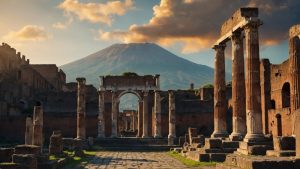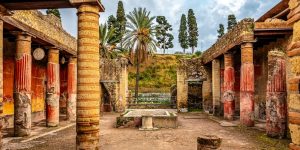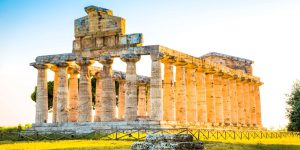What is the Pompeii Visitor Limit?
Basilicata, Inspiration, Pompeii, Tours and experiences, Travel Tips
How the Pompeii visitor limit will affect your trip and how to still enjoy Italy’s UNESCO world heritage sites.
Pompeii has always been on the list of must-see places for tourists to visit in Italy. Following the eruption of Mount Vesuvius in 79 AD the city of Pompeii lay undiscovered under layers of ash until the 18th century. Remarkably, the unique qualities of the ash preserved the Roman city and today visitors can experience incredible insights into Roman life. However, Italian authorities have announced that from the 15 November 2024, there will be a visitor limit in Pompeii to help combat over tourism.

What is the Pompeii Visitor Limit?
From the 15 November 2024 there will be a daily visitor limit in Pompeii of 20,000. This may seem like a lot but the archaeological park has had a record breaking year. In 2023 four million visitors visited Pompeii, which is a third more than any previous year, and this has sparked fears that the site will deteriorate due to over tourism.

However, if you plan to visit Pompeii, don’t despair! Over the past year, even in its busiest month (May 2023), the park saw an average of approximately 16,700 visitors per day pass through the gates. Well below the new 20,000 visitor limit. That said, there are have been some days this year where there have been more than 36,000 people enter the site. This seems to be a particular issue on the first Sunday of each month when entry to the archaeological park is free of charge.
Similar restrictions have already been introduced in Venice, where fears of over tourism have grown in recent years. Here there has been a new €5 levy charged on 29 ‘peak days’ in 2024. Additionally, they have banned group tours of more than 25 people operating in the city. While some of these actions may seem a little draconian, as the world suffers from so many issues due to climate change and overpopulation, perhaps it is a good thing that Italian authorities are taking action to preserve its sites so we can all enjoy them in the future too.

How to Navigate the Pompeii Visitor Limit
Planning ahead is the key to navigating the Pompeii visitor limit. As I think we’ve explained, based on previous visitor numbers, the cap will probably only come into action on a handful of days each year. That said, there are some very simple things you can do to help make sure you are not left stuck outside the gates!
Here at Bookings For You we are huge fans of Italy’s historical sites. And while we may consider ourselves to be keen historians, we always recommend using a guide to get the most out of your experience. Very often the guides are archaeologists themselves and have a wealth of knowledge. Additionally, they are are incredibly skilled in sharing their knowledge in a wonderfully entertaining way. We have always booked these in advance. We like the peace of mind this gives us that we will have a great guide for our tour. However, we also like the fact that when tours are booked in advance, they often come with a skip-the-line option. This can be especially useful if you’re travelling in the peak summer months. Temperatures in the region are often well above 30 degrees – not good queuing weather! Book you skip-the-line tickets here.

Top Tips to Navigate Pompeii Visitor Limit
-
- Arrive early. The park is open from 9.00 – 19.00 in the summer and 9.00 – 17.00 from November to March.
- Book tour tickets in advance – this will guarantee your entry to the park.
- Avoid the first Sunday of the month. Although entry is free it’s often not worth the compromise of the crowds.
- Consider visiting in the spring, autumn or even the winter.
- Enjoy the whole park. The city of Pompeii is just part of the archaeological site. There are villas, dedicated museums and an antiquarian. These are often far less crowded than the city of Pompeii itself.
- Consider our alternatives to Pompeii – Italy has 54 cultural UNESCO world heritage sites.
Alternatives to Pompeii
Of course, we understand the draw of visiting Pompeii. It is an incredible site. However, the news of the new Pompeii visitor limit has reminded us that Italy has so many more less visited archaeological and historical masterpieces. Home to 54 designated cultural UNESCO world heritage sites, Italy has much more to offer than just Pompeii. Here are a few of our favourites.
Herculaneum
Perhaps the most obvious alternative to Pompeii, Herculaneum is arguably better preserved than its neighbour. And what’s more, it is much less busy and more suited to a shorter visit. Herculaneum can be explored quite comprehensively in just 2 or 3 hours. It takes just 30 minutes to drive between Pompeii and Herculaneum, however the affect of the eruption, even in this short distance, had quite different outcomes.

As Pompeii is nearer to Vesuvius, it took a more direct hit with some of the city being instantly incinerated by the heat of the eruption. However, as Herculaneum was further away it took less damage and was immediately covered in a blanket of preserving ash. The outcome is that much of the city is even better preserved than Pompeii. What’s more, Herculaneum was more affluent than Pompeii so the artwork and artefacts here are even more impressive.

Ruins of Oplontis
Between the sites of Pompeii and Herculaneum lie the ruins of Oplontis. Here you’ll find two Roman villas which came to a similar fate as their more famous neighbours, on that fateful day when Vesuvius erupted. After extensive archaeological excavation, the first villa to be discovered is believed to have been the holiday home of Emperor Nero’s wife. Villa Poppaea is an opulent residence housing private baths and even a swimming pool. The interior of the villa has some remarkably well preserved art work on its walls. This is an active archaeological site with some parts of the villa still being excavated from beneath the modern settlement of Torre Annunziata.

Also at Oplontis, visitors will find the smaller Villa of Lucius Crassius Tertuis. Historians believe that this villa dates back as far as 2 BC. Since its discovery, many incredible artefacts have been discovered here, including jewels, coins and ceramics.
Paestum
Just south of Sorrento and the Amalfi coast, Paestum is a magnificent site, yet too often it falls off the radar for visitors to Italy. Here you’ll find three incredibly well preserved Greek temples along with the remains of the ancient city. As this site is less visited than Pompeii, you will find you have much more time and space to explore the ruins.

The rural location gives the archaeological park a stunning backdrop. You are able to wander around the site and discover ancient settlements which lie in the shadows of the magnificent temples. There is also a museum just opposite the park entrance. Make sure you don’t miss the Tomb of the Diver where there is some stunningly well preserved artwork to admire.

Like Pompeii, a day is enough to enjoy Paestum. We would recommend adding it to a tour of Italy or a day trip from Rome or Sorrento.
An Alternative Away from Pompeii
Matera, Basilicata
If the visitor cap still puts you off heading to Pompeii, then we have a great alternative to suggest to you. In our opinion, Matera is an incredible historical site and also one of Italy’s modern masterpieces. The story of Matera begins in the Palaeolithic and Neolithic eras but has continued well into the 20th century. Tucked into a hillside in Basilicata, Matera remains largely undiscovered by tourists.

Matera’s Story
The ancient city is a settlement of cave dwellings (sassi). Historians believe people began to live here on a larger scale form the 8th century. As Italy moved forward in time, life in Matera almost stood still. By the 1950s most of the dwellings lacked basic amenities such as electricity and running water. In 1952, following a visit from the Prime Minister, the government declared Matera and its archaic living conditions, ‘the shame of Italy’. Shortly after, its residents were forcibly evicted form their cave houses.
After people moved to accommodation in the modern quarter of the city, archaeologists began work on discovering Matera’s fascinating history. Until then it had remained hidden in its myriad of caves. In 1986, the Italian government passed a law allowing people to return to their sassi. While most people had become accustomed to the creature comforts of modern life and didn’t want to return to live in their sassi, this prompted a wave of renovation to begin. The result is one of the finest juxtapositions of perfectly preserved ancient history and modern easy-to-consume tourism that we’ve ever experienced.

Many of Matera’s sassi are now beautiful shops, hotels and restaurants. Their renovation is a fine example of how it is possible to both preserve history and welcome modern tourism. However, much of the ancient city remains uninhabited and acts as a ‘living museum’. Archaeologists have worked tirelessly to uncover the centuries of history and the project will continue for many years to come.
Matera is a wonderful ‘add on’ to a holiday in Puglia. Click here to see our stunning collection of Villas and apartments in the region.
More information on historical sites in Italy
To learn more about Italy’s magnificent historical sites visit the Bookings For You Blog. And if you’d like some advice on accommodation in Italy contact our team at Bookings For You.



